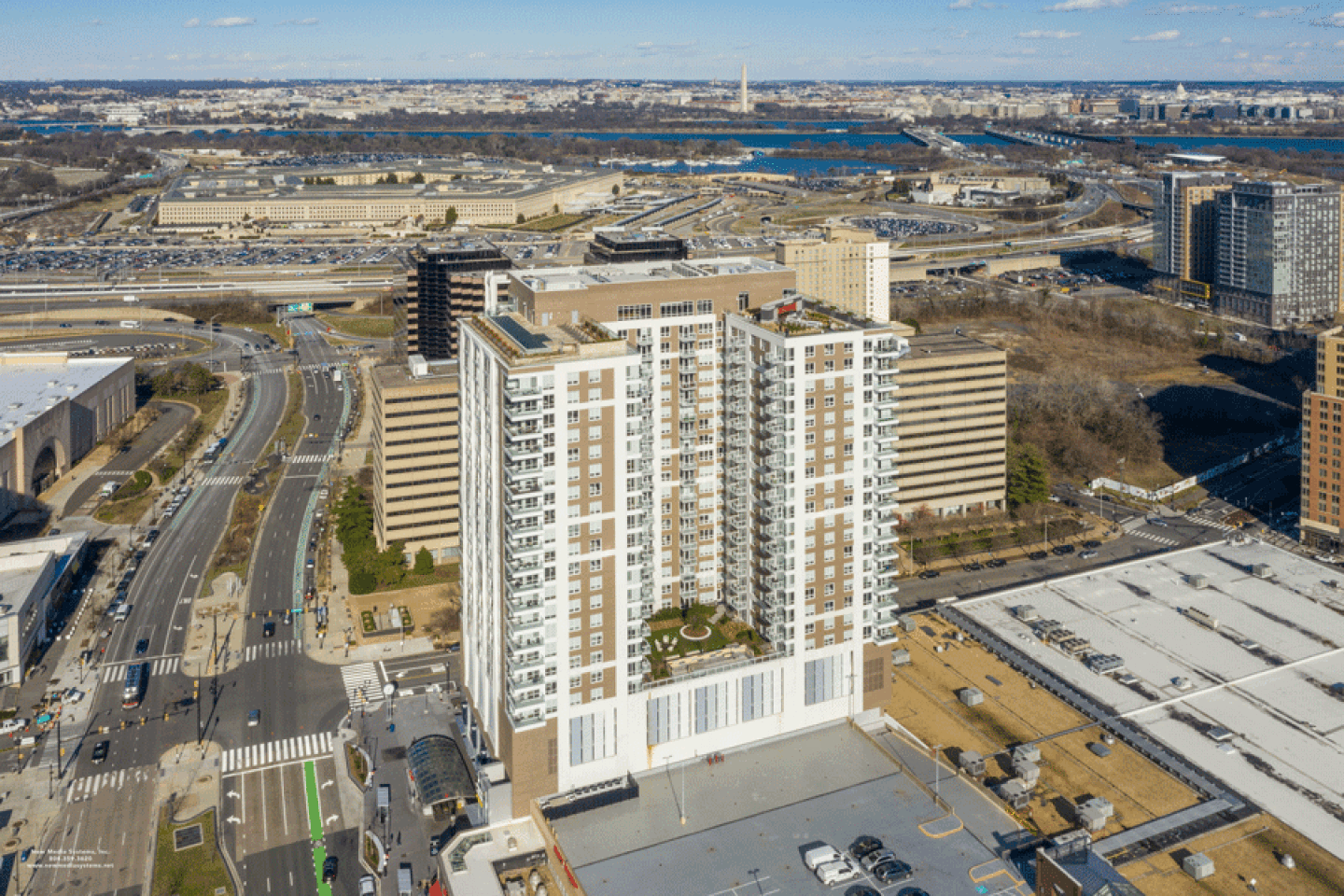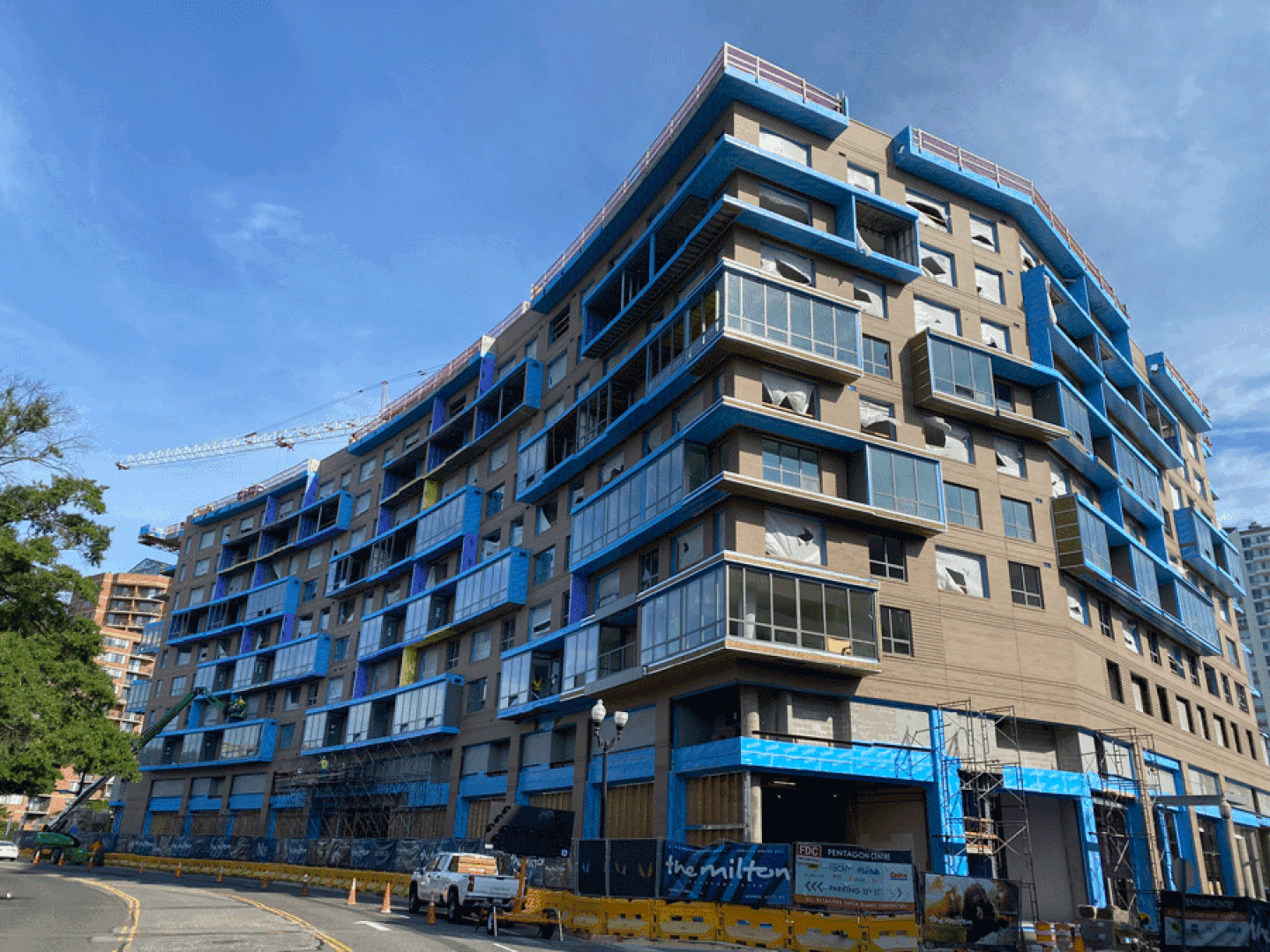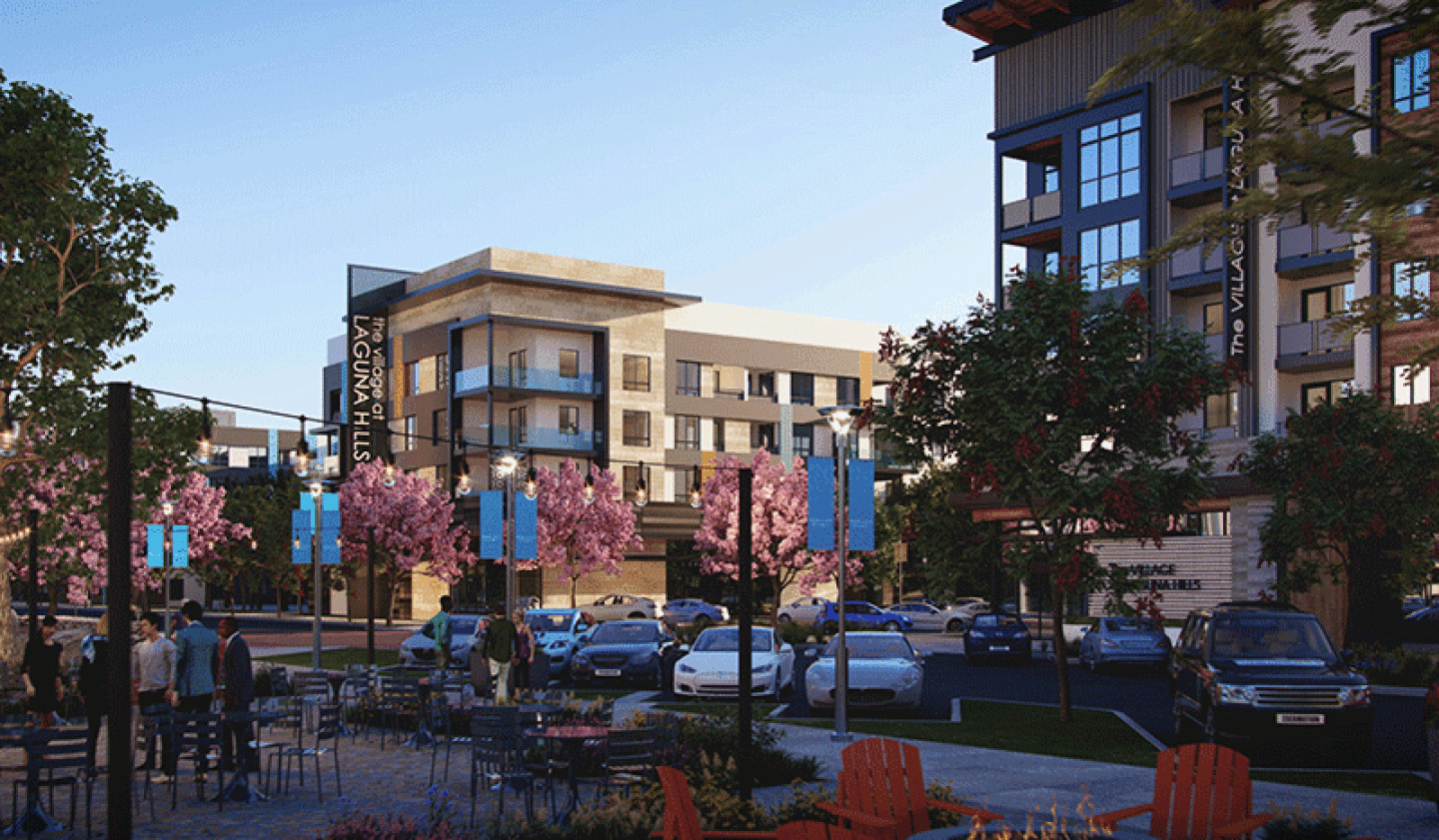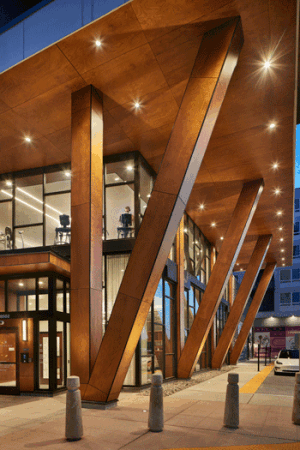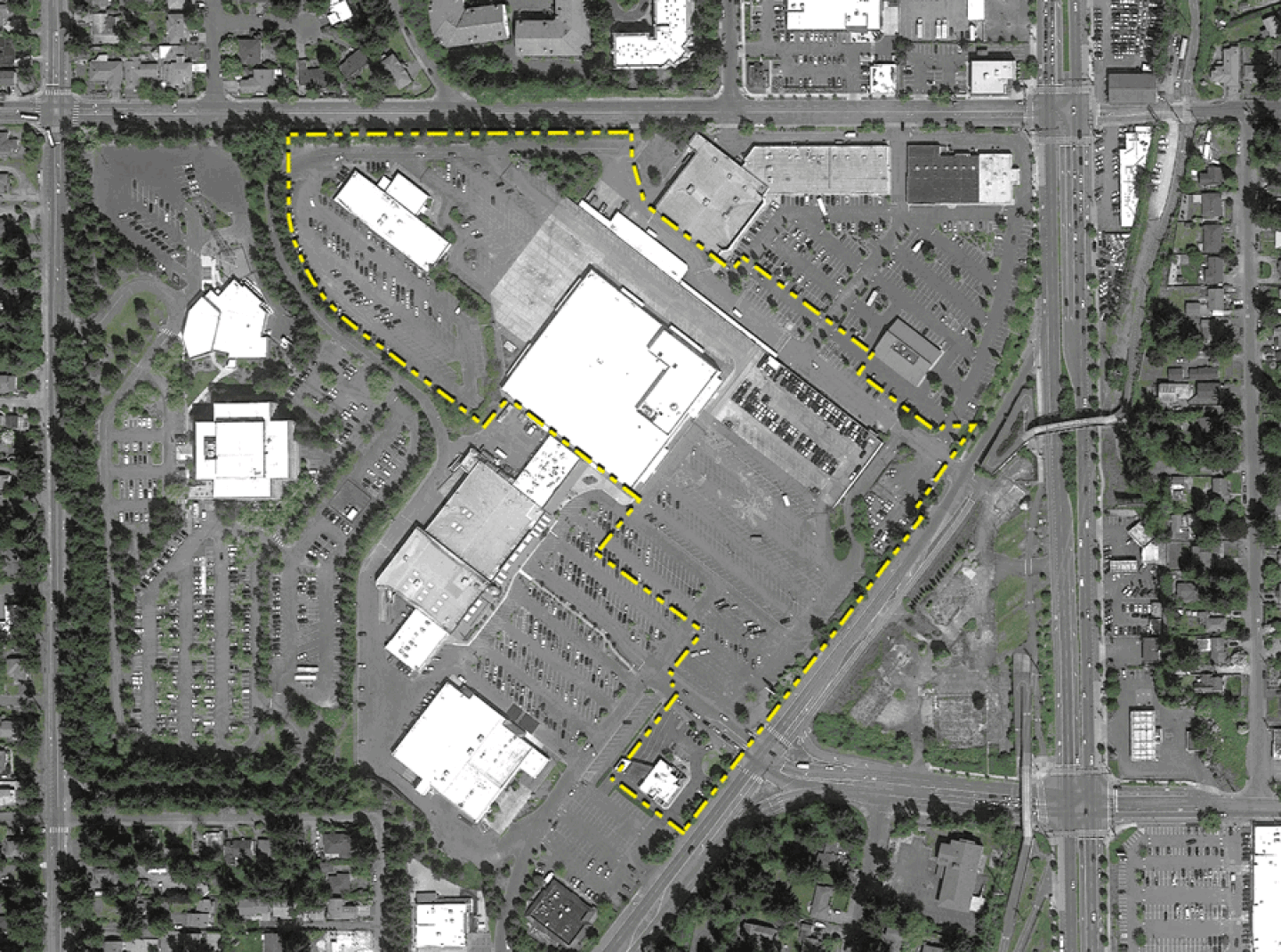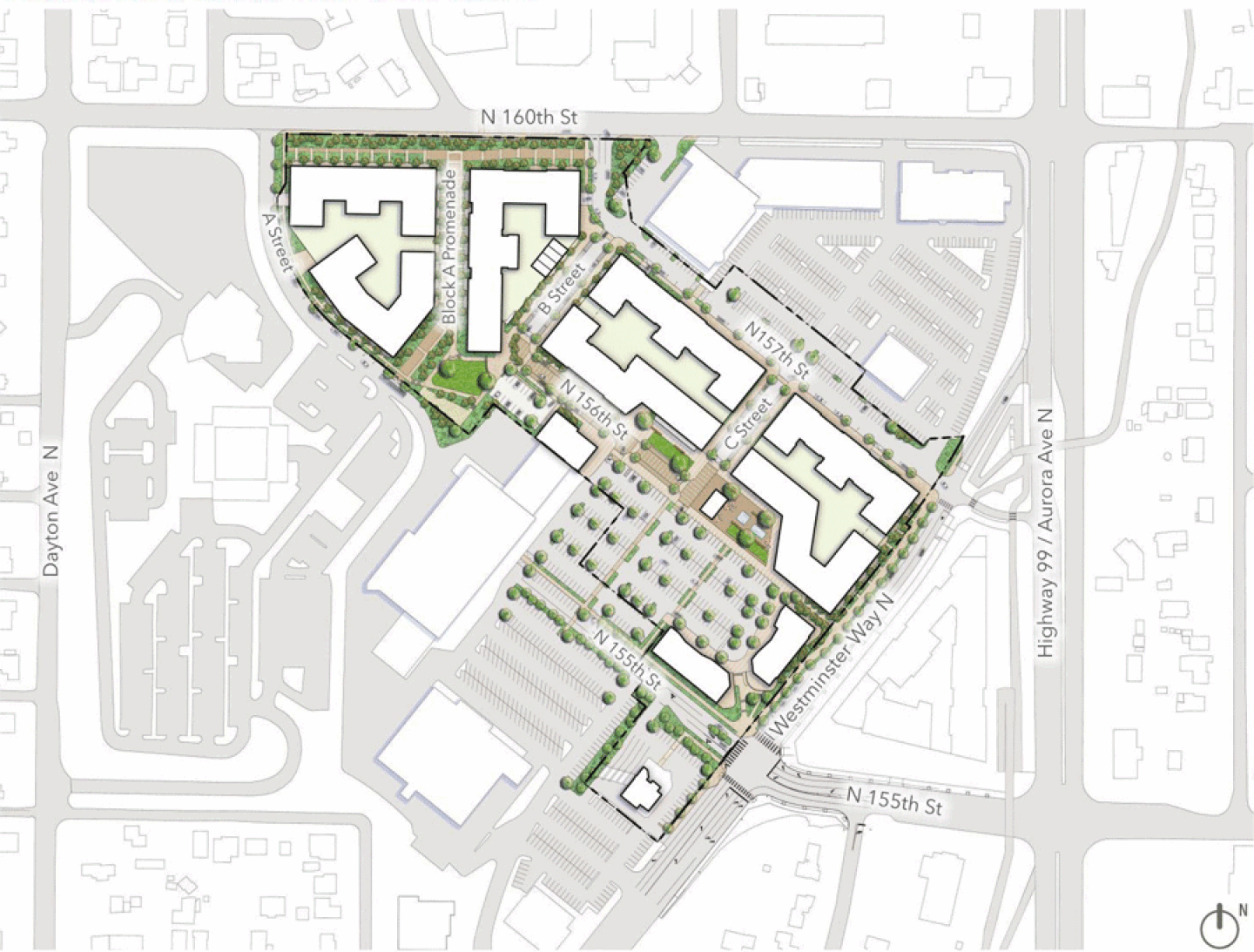From apartment buildings rising in shopping center parking lots to the redevelopment of dead-mall sites as housing, retail-to-residential conversions are an increasing trend.
In the Pentagon City area of Arlington County, Virginia, Pentagon Centre is not just a place where people can peruse electronic gadgets at Best Buy, get deals on clothing at Nordstrom Rack and Marshalls, or stock up on everything from paper towels to golf balls at Costco. They can actually live right next to their favorite stores in the Witmer, a 26-story, 440-unit luxury apartment building that towers over the complex. It is equipped with a state-of-the-art fitness center, a rooftop pool, and other upscale amenities, plus it offers the convenience of a location close to both downtown Washington, D.C., and Amazon’s East Coast headquarters.
When the Witmer opened in 2019, “we leased up in, like, six to eight months,” explains Geoff Glazer, senior vice president of Kimco Realty, a nationwide owner-operator of retail centers. “It was crazy to watch that happen.”
The building’s success bodes well for the Milton, an 11-story, 253-unit curvilinear residential building that is near completion on the other side of the complex. “We’re thinking about doing a third one,” says Abbey Oklak, Kimco’s director of multifamily redevelopment.
Learn more about innovation in development: ULI Learning | 2024 ULI Spring Meeting
The Witmer, the Milton, and residential infill projects that Kimco has developed in Pennsylvania, Texas, and elsewhere exemplify a trend gaining momentum across the nation. Retail-to-residential conversions range from apartment buildings that are springing up in what were once mall parking lots or the former sites of closed big-box stores, to partial or complete “scrapes” in which malls and shopping centers are torn down and replaced with mixed-use communities with plenty of housing.
At a time when physical retail faces difficult competition from e-commerce, retail center owners increasingly see residential as both a new revenue source and a way to invigorate stores by putting potential consumers in close proximity. And for suburban malls and shopping centers that are in decline or already closed, demolishing and replacing them with apartment buildings and townhomes is a way to capitalize on what often are desirable locations in inner-ring suburbs or along major transportation corridors.
Although there are often tricky challenges to turning what was once a sea of asphalt and concrete and enormous windowless mall buildings into pleasant mixed-use neighborhoods, architects and urban theorists describe them as an opportunity to bring walkable urbanism to the suburbs, as well as alleviate housing shortages.
“It’s an evolution of the ‘live, work, play’ or town center concept,” says Caitlin Sugrue Walter, vice president of research for the National Multifamily Housing Council. “It’s a win-win situation—more units are built, which will improve affordability. And those residents will provide spending power for the local businesses.”
Why Retail-to-Residential Is Rising
Retail-to-residential conversions aren’t new. Kimco first got interested in them about eight to 10 years ago, about the time that the shakeout in big box stores began. “We started seeing that it was going to be an opportunity to add something new to our properties,” Glazer explains. Multifamily residential seemed like a complementary fit with the stores in Kimco’s centers, putting customers on the property who would buy groceries and patronize dry cleaner shops and nail salons. The added activity around the clock “really gave the leasing team some great opportunities to bring up the quality of the retailers on some of these properties,” he adds.
The trend gained momentum during the pandemic, when restrictions exacerbated many retailers’ woes and pushed center owners to look at other uses. Las Vegas-based real estate advisory firm StoneCreek Partners predicts that redevelopment and reuse of shopping malls will be the most active asset class in 2023. StoneCreek identifies more than 150 malls across North America that either have been redeveloped in recent years or are in the works. Some are being converted to recreational uses, data centers, or e-commerce fulfillment.
But retail-to-residential conversions seem to be leading the way. “Shopping mall repurposing to include residential infill or full scrape and redevelopment, is keeping a lot of developers busy,” explains StoneCreek leader Donald Bredberg. “So many shopping malls are well located within their communities, generally in good settings for multi-family development.”
At a time when many brick-and-mortar retailers are struggling, residential appeals to real estate investors as a potential source of new revenue because apartment rents tend to rise more quickly in response to market conditions, according to Mandi Wedin, founder and CEO at Washington, D.C.,-based Feroce Real Estate Advisors. In contrast, “in big box retail, your rent is set for a long term,” she notes. “You can catch increasing rents on an annual basis.”
By repurposing greyfield sites rather than greenfields, conversions also improve sustainability, says architect Daniel Gehman of Danielian Associates, based in Irvine, California, who has worked on numerous retail-to-residential projects. Stormwater that once collected residue from cars in asphalt parking lots, for example, can instead be diverted and treated in new residential projects. “It just is better for the environment,” he says. “It fits with the whole idea of developing places that are already developed and densifying, as opposed to just sprawling everywhere.”
Overcoming Difficult Obstacles
Despite their potential benefits, residential-to-retail conversions can face daunting hurdles. Malls often have multiple landowners and leasing and contractual tangles that can necessitate negotiations with the remaining tenants. “An anchor store may own its building and the land underneath it,” explains June Williamson, an architecture professor at the City College of New York and co-author of the 2021 book Case Studies in Retrofitting Suburbia. As a result, it can become “kind of an island in a sea of land that’s owned by another entity.”
Texas-based developer Centurion American had to navigate those and other challenges when it set out to remake Collin Creek Mall in Plano, Texas, near Dallas. When the mall opened in the early 1980s with great fanfare, it attracted shoppers from as far away as Oklahoma. But two decades later, it was in decline when Centurion American bought the main mall building and one of its department stores, according to Centurion American vice-president Rob Romo. The firm then had to make separate deals to buy several other stores and worked out a complicated arrangement with the last remaining major retailer, which under its operating agreement had to approve any redevelopment plans. Centurion American agreed to provide another site and pay for construction of a new store before the retailer’s bankruptcy led it to sell the land outright.
Getting complete control of a mall site is the biggest challenge, Romo explains. “It doesn’t matter if you have two or three, or all of them except for one—that last party effectively has equal control over the site.”
“If there is a more complicated real estate play than a regional mall, I don’t know what it is,” says Peter Braster, the City of Plano’s director of special projects.
The developer also had to deal with the problem of what to do about aging stormwater culvert system that ran through the site. Initially, the city wanted to replace it, which could have delayed the mall redevelopment by years, until Centurion American’s engineers came up with a way for Plano to reinforce the existing culverts instead, Romo recalls.
It wasn’t until those issues were resolved that Centurion American could proceed with its plan to convert the mall to a mixed-use community, in which it retained the core mall and 325,000 square feet (30,193 square meters) of retail but tore down the big boxes, to make room eventually for 2,300 units of multifamily housing, 500 single-family residences, and 1.5 million feet of office space. The first 400 apartments are scheduled for completion in late 2024. Eventually, Plano’s new live-work-play neighborhood will be home to 6,000 residents, providing plenty of consumers in proximity to its retail.
Rethinking the Mall to Create Mixed-Use Communities
In California, where malls proliferated in car-centric suburbs, many are now undergoing major transformations.
For some, residential infill is just the latest stage of evolution. In Huntington Beach, for example, an aging 1960s-vintage indoor mall initially was remade into Bella Terra, an open-air town center with Tuscan-inspired architecture and tenants such as upscale grocer Whole Foods. Now, owners DJM Capital Partners and PGIM, the real estate arm of Prudential Financial, are planning to demolish a building that once housed Burlington Coat Factory to make way for a U-shaped complex that include a five-story, 300-unit residential portion atop 43,000 square feet (3,995 square meters) of new retail on the ground level.
“We reviewed many different options for Burlington over the years, but given that big box retailers are downsizing today, replacing this massive retail box with much-needed housing is the best fit for Bella Terra and the community,” explains Rob Grant, senior vice president for investments at DJM.
Some of the conversions involve rethinking the very concept of malls, in an era when younger Millennials and Generation Z members seem increasingly disinclined to drive.
“To sustain a mall into the next generation, it should be embedded in a mix of activated, walkable uses that include residential,” explains Barry Hand, a principal and studio director in the Dallas office of global design firm Gensler. “Existing malls are somewhat interior facing surrounded by surface parking. We are currently working on a significant conversion of MainPlace Mall in Santa Ana, California, where the design opens the mall in strategic areas and somewhat blurs the line between interior/exterior from one side of the mall to the other.”
Gensler’s reimagining of MainPlace includes densifying the perimeter with entertainment, office space, and multifamily housing that Hand envisions bringing expanded foot traffic to the retail portion each day.
Not far away, Laguna Hills Mall, a 1970s-vintage center situated near the I-5 freeway, is undergoing a dramatic overhaul that involves completely demolishing the massive mall building at the core and replacing it with five multifamily residential buildings with 1,500 units, a hotel, and green space. The 68-acre (27.5 ha) site also still include 250,000 square feet (23,226 m sq) of retail, including fitness facilities and a movie theater, and 500,000 square feet (46,452 square meters) of office space out along the freeway. Rebranded as the Village at Laguna Hills, the former mall will become a dense urban-style community with “truly walkable environment” and a mix of retailers catering to residents’ needs, according to Scott McPherson, a managing partner at Merlone Geier Partners, the real estate investment firm undertaking the overhaul.
In addition to malls, single-level shopping centers are being scraped as well so that the land can be repurposed for housing. In San Jose, developers Maracor and Pacific West Communities have filed plans to tear down Maplewood Plaza, a 23,800 square-foot (2,211 m sq) shopping center, and replace it with a six-story, 260-unit apartment building that also will include ground floor retail. “Sites like Maplewood Plaza sit on transit corridors that have been upzoned for height and density over the years,” explains Maracor principal Brad Dickason.
Living at the Mall
In its work on mall redevelopment, Seattle-based architecture firm GGLO has focused on how to insert residential into the mall environment and achieve a harmonious balance. One salient example of GGLO’s work is Avalon Alderwood Place, a mixed-use 328-unit multifamily development located on the former site of a Sears department store at Alderwood Mall in Lynnwood, Washington, which it designed on behalf of development partners AvalonBay Communities and Brookfield Properties.
In contrast to declining malls that developers can drastically overhaul, Alderwood “is considered a pretty successful mall,” explains GGLO architect and principal James Bradley. “Most of our work was around, how do you create that sort of residential experience, and things that residents want to have that sense of home, that sense of a residential place and neighborhood, within the existing fabric of a fully-functioning mall?”
To achieve that, GGLO came up with a biophilic, or nature-inspired, design that emphasized the environment of the Pacific Northwest—the connectedness with the mountains, for example—and used materials such as wood and stone, and colors that occur in nature. “We’ve tried to bring in those sorts of natural materials and colors as a kind of response to the mall itself,” Bradley says, adding that “it’s meant to be contrasting and complementary at the same time. We’re trying to blend the two.”
The building, which opened in 2022, includes subtle architectural clues—such as the cantilever that accentuates the lobby—and an amenity deck with views of the Cascade Mountains, “as kind of a further visual connection with our region.”
GGLO also has designed housing infill for Shoreline Place, a strip mall 12 miles north of downtown Seattle, on behalf of developer Merlone Geier, which bought a portion of the site. In addition to about 1,000 new housing units, the plan involves demolishing another massive former Sears building and creating the equivalent of a walkable downtown core, with interconnected open spaces that will function as “public living rooms,” according to a description on GGLO’s website. It also will include a network of vehicle and pedestrian pathways, and a Festival Street designed to house the local farmer’s market. The mall’s conversion to a mixed-use community could take 10 to 20 years, according to the city of Shoreline’s website. As with Alderwood, the challenge is creating an identity that residents can connect with- “how are you going to create a ‘there’ there,” says GGLO architect and principal Jeff Foster.
Kimco’s Geoff Glazer, in contrast, sees the goal of placemaking in retail-to-residential redevelopment in more bottom-line economic terms. “We want people to stay on our properties longer,” he explains. “The more we can keep people on our properties, the better our retailers will do.”
More from ULI: How to Make Office-to-Residential Conversions Work

